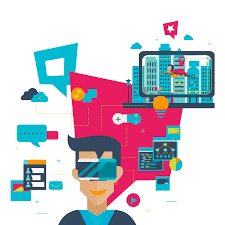Augmented Reality (AR) and Virtual Reality (VR) in Digital Marketing: Enhancing User Experiences with AI
Augmented Reality (AR) and Virtual Reality (VR) in Digital Marketing
Augmented Reality (AR) and Virtual Reality (VR) are immersive technologies that have the potential to revolutionize the way digital marketing is conducted. By combining these technologies with artificial intelligence (AI), businesses can create highly engaging and personalized user experiences. Here's how AR, VR, and AI can enhance user experiences in digital marketing
 |
| Ref. Google |
1. Personalized Product Visualization: AR and VR can allow customers to visualize products in a realistic and interactive way. By using AI algorithms, marketers can analyze user preferences, purchase history, and other data to recommend products and create personalized AR/VR experiences. This helps customers make more informed purchasing decisions and increases their engagement with the brand.
2. Interactive Advertising: AR and VR can transform traditional advertisements into interactive and immersive experiences. By leveraging AI, marketers can create dynamic content that responds to user behavior and preferences. For example, AR ads can overlay virtual elements on the user's real environment, while VR ads can provide a fully immersive experience. AI algorithms can analyze user interactions and adapt the content accordingly, improving engagement and conversion rates.
3. Virtual Try-On and Test Drives: AR and VR can enable customers to virtually try on clothing, accessories, or even test drive vehicles before making a purchase. AI can enhance these experiences by providing real-time recommendations, analyzing customer feedback, and refining the virtual try-on or test drive process. This technology allows customers to make more confident purchase decisions and reduces the likelihood of returns or dissatisfaction.
4. Gamification and Interactive Experiences: AR, VR, and AI can be combined to create gamified experiences that engage and entertain users. By incorporating game mechanics and AI-driven personalization, marketers can create interactive campaigns, quizzes, or challenges that encourage user participation and foster brand loyalty. These experiences can also collect valuable data on user behavior and preferences, enabling better targeting and segmentation.
5. Virtual Showrooms and Tours: AR and VR can transport users to virtual showrooms or provide virtual tours of physical spaces. By leveraging AI, marketers can customize these experiences based on user preferences and behavior. For example, an AI algorithm can analyze user interactions during a virtual tour and recommend specific products or services tailored to the user's interests. This enhances the user experience and increases the likelihood of conversions.
6. Social Media and Influencer Marketing: AR filters and VR experiences can be integrated into social media platforms, allowing users to engage with brands and influencers in new and immersive ways. AI can analyze user-generated content, such as images or videos, to provide personalized AR effects or VR experiences. This creates a more interactive and shareable content ecosystem, driving user engagement and expanding brand reach.
In summary, the combination of AR, VR, and AI in digital marketing enables businesses to create highly engaging and personalized user experiences. By leveraging these technologies, marketers can provide interactive product visualizations, gamified experiences, personalized recommendations, and immersive advertising campaigns. This not only enhances user engagement but also increases brand loyalty, conversions, and customer satisfaction.


Comments
Post a Comment